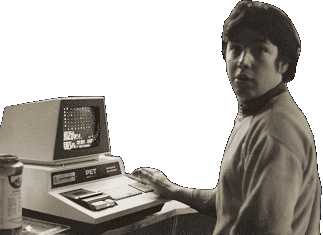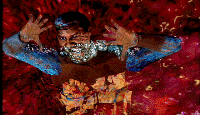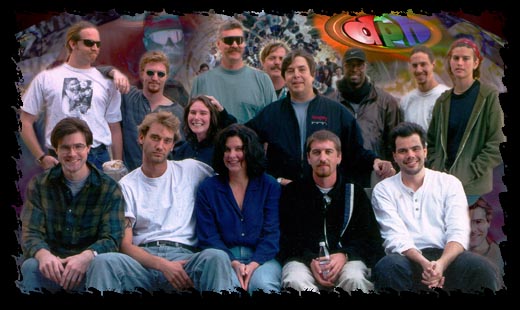
Primarily, digital phenomena is the on going effort of its initial founder (myself) Jamie Clay. dph's "product" has been the work of both the single person and the efforts of a crack team of CG mercenaries. The staff and facilities at dph change size based on the projects scheduled. The following is a chronology of dph's origin. I intend this section to grow in detail.
Gumby, Godzilla, HG Wells and Ray Harryhausen form the foundation of my love for special effects. With my eyes glued to the magical images the seed was being planted deep. On a trip to California, when I asked how they made Gumby move, my father told me of stop-motion animation and gave me my first Gumby. It was that long ride back to Maryland where I fantasized about making my own Gumby movies.
Fireball XL5, Star Trek, Bewitched, Lost in Space and My Favorite Martin add fuel to my interests in special effects, so by 1966 armed with an 8mm movie camera, I finally got the chance to explore making them for myself. There were a few attempts at stop motion animation but mostly you saw things disappear, explode and move about in an unnatural manner. As you might guess, there were many "test" reels with just a couple of "full feature films" getting produced.
When personal computers began to show up in the late '70s, I dove into the wonderful world of tape drives and basic programming, soon discovering that I had an unusual rapport with the beasts. My big project this decade was converting "Start Trek" game over to the more contemporary "Battle Star Galactica" for the Pet 2000.

This talent eventually got me work at Autodesk, Inc. in 1986 in their Product Support group. During this time I became a key player in Autodesk's animation software development working with John Walker on Autodesk's first animation package, AutoFlix (for use with AutoCAD and AutoShade), and then moving on to do all the development on AutoFlix 2.0 which included the Animation Tool Kit for AutoCAD.
Using this early PC based animation software, along with Autodesk Animator, I helped Nano Technologist Eric Drexler (author of Engines of Creation) to visualize how nano machines might look. This animation was used in the BBC documentary "Little by Little" and was the first time an Autodesk animation product had been used for broadcast television.
Working closely with the Yost Group (the authors of Animator Pro and Autodesk's 3D Studio software), I assisted in the design and testing of the software, often defining the methods that could be used to achieve a wide range of special effects.
When 3D Studio was a few months away from release, Gary Yost realized we needed to "production test" this new product, so thanks to my previous involvement with Autodesk Animator, I was given the "unofficial" duty to manage a collection of computers (not networked) that were quickly assembled for the making of "The Bored Room". (special thanks to Compaq Computers)
As far as anyone seems to know, the term "Render Farm" was coined during this production by Bob Bennett when he was commenting on my regular attire of farmer's bib coveralls.
Leveraging the production experience from "Bored Room" and producing many of the initial animations that Autodesk used to promote its products, I founded and managed Autodesk's first internal team of digital artists whose charter was to do production testing with the byproduct of producing material for Autodesk's Marketing needs.
This production group grew to about 15 employees and went from a group with tech to an autonomous group reporting to the director of corp marketing. We were producing everything from promotional CD ROMS to images for ads, posters and of course corporate videos - all the while delivering design testing and feedback for now a wide range of Autodesk's products, not just 3D Studio.
One might ask why I left, was I crazy? Nope, I had just grown beyond the changing corporate climate at Autodesk. It was time to move on and on a fitting note my "farewell" email bounced between the corporate mail servers for the US and England, causing everyone in the company to receive it few dozen times.
 After
short "retirement", in
1995 I opened up a small one man studio at "Jr. Walker Ranch" and founded digital phenomena, specializing in digital image effects.
One of the first projects was assisting the completion of Paramount's Film "Virtuosity."
I created special visual effects depicting Denzel Washington's virtual fall and
subsequent atomization in the film's climactic ending sequences.
After
short "retirement", in
1995 I opened up a small one man studio at "Jr. Walker Ranch" and founded digital phenomena, specializing in digital image effects.
One of the first projects was assisting the completion of Paramount's Film "Virtuosity."
I created special visual effects depicting Denzel Washington's virtual fall and
subsequent atomization in the film's climactic ending sequences.
Shortly there after Kevin O'Lone (my brother-in-law) joined dph to grow it into a larger business and in 12 months we did just that. At our peak we had 14 staff members (plus a good number of interns) doing simultaneous work on films, games and broadcast projects.

back row: Karl Raade, Jonah Loop, Kevin O'Lone,
Peter Clay, Lance Thompson, Dan Hicks, Laurel Roth
middle row: Kim Brown, Jamie Clay
front row: John Kirby, Walter Grey, Jeanne O'Lone, Scott Johnson,
(Alt) John Arnold
In early 1998 we were prepared to move into doing series television after creating the "sales kit" for "Real Life adventures of Jules Verne" but the client decided to go with another group located in Montreal Canada. (don't you hate it when that happens) Unfornately we had put too many eggs in that basket, so at that point we decided to cut our losses and move back to Jr. Walker Ranch to reduce our overhead.
Most of the staff moved on and stayed within "the biz", some went on new adventures and much to my relief they're all doing well.
2000
So digital phenomena is now back to where it was in the beginning, only with a greater wealth of resources and experience.